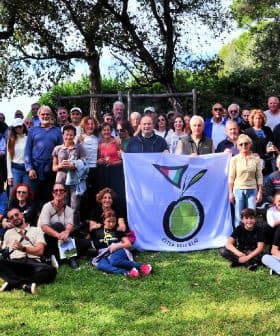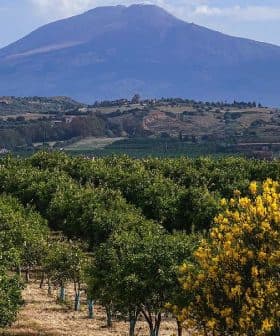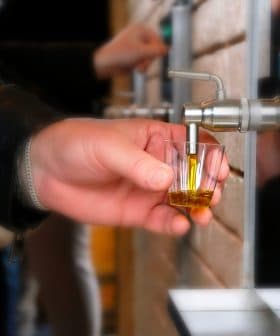 5.9K reads
5.9K readsWorld
Oldest Known Bottle of Olive Oil on Display in Naples Museum
The National Archaeological Museum of Naples will soon exhibit the world’s oldest known bottle of olive oil, which comes from an ancient Roman town destroyed by Mount Vesuvius in 79 A.D. The well-preserved glass container, almost full of solidified olive oil, was discovered during the filming of a TV show and is being analyzed to confirm its authenticity and learn more about ancient olive oil usage.
Likely the world’s oldest known bottle of olive oil will be soon exhibited at the National Archaeological Museum of Naples (MANN), where it was recently presented during a press conference given by the director of the museum, Paolo Giulierini, and the paleontologist and TV host, Alberto Angela.
We have a much better-preserved glass bottle containing an abundant quantity of material, which immediately proved that it is an edible oil.
The dainty well-preserved glass container, almost full of what is almost certainty solidified olive oil, comes from one of the ancient Roman towns (most likely from Herculaneum), which were destroyed by the eruption of Mount Vesuvius in 79 A.D.
Angela’s crew was working on the popular show ‘Tonight in Pompeii,’ broadcast on Italy’s national network RAI1, when they noted the bottle in the warehouses of MANN. Then, the relic was brought to the attention of experts of the Department of Agricultural Sciences (DIA) of the University of Naples ‘Federico II,’ which were working on a line of research into ancient food, through an agreement with the Museum.
“The bottle was kept in the museum’s warehouses, and sometimes displayed in public during special events,” Gaetano Di Pasquale, of the Laboratory of Vegetation History and Wood Anatomy of DIA told Olive Oil Times. “However, considering the great interest that it generated thanks to its great conservation status, we decided to conduct further research, and to display it to the public in a three-month exhibition at MANN, which will open on 31 October,” revealed the researcher, who will take care of the show with Alessia D’Auria on behalf of DIA.
He explained that there are several ancient crates and jugs containing traces of organic substances which have been described as olive oils, but the data related to the analyses performed over the last centuries can no longer be found.
“The excavations of Pompeii and Herculaneum began in the mid-1700s, then in the museum’s storerooms there is plenty of material discovered over last centuries, and part of the documentation relating to these finds is still unclear,” he pointed out. “That is why MANN entered into an agreement with DIA, in order to re-analyze and re-catalog all the food findings with the methods available to us today, and our olive oil bottle became part of this line of research.”
At this point, it would be interesting to understand where it has been stored, in order to get more information on the context and, therefore, on the use of olive oil at that time. We know that it was originally used as lighting fuel and as a cosmetic, and it started to be used as a food quite late.

Raffaele Sacchi
The organic material contained in the bottle in the form of “white-yellowish, brownish and blackish glomeruli with a waxy consistency,” was then subjected to chemical-analytical investigations including, among others, carbon-13 and proton nuclear magnetic resonance spectroscopy, gas chromatography with capillary columns of fatty acids, and carbon-14 dating.
“Let me say in advance that, as early as the 1990s, I studied the olive oil contained in a small cruet coming from the excavations of Pompeii,” revealed Raffaele Sacchi, a professor of agri-food industries and Mediterranean diet ingredients and products, and chair of the division of Food Science and Technology at DIA, who is conducting the analysis.
“It was the typical glass vial which was supposed to contain a scented ointment, a cosmetic. Even then, tests revealed that inside was a vegetable oil, almost certainly extracted from olives,” he specified. “In this case, however, we have a much better-preserved glass bottle containing an abundant quantity of material, which immediately proved that it is an edible oil, and this was confirmed by the shape of the bottle designed as a modern ‘oliera,’ namely an olive oil dispenser.”
An analysis gave us more specific indications with respect to the identification of the type of oil contained: palmitic-stearic acid ratio, oleic acid presence, and the ratio between long-chain fatty acids univocally matched olive oil composition, affirmed Sacchi.
Then, according to the analytical data reported by our expert, this can be considered the most ancient container with the greatest quantity of olive oil ever studied (and survivor of an eruption), which is a significant find compared to the more common artifacts like remnants of vases and amphorae containing extremely few traces of olive oil.
Researchers are now performing the Carbon-14 dating to make sure that the bottle is not a reconstruction of the Bourbon period (1700) when the archaeological site was first excavated. “However, I believe this is far-fetched, and almost certainly the find dates back from the period of the eruption, because the content profile is very similar to the one that I analyzed thirty years ago,” Sacchi observed, specifying that a portion taken from the surface of the solidified matter has been studied, and then they will conduct a capillary sampling of an innermost portion, which is better preserved.
They will perform other tests, such as an analysis of sterols by mass spectrometry to confirm the botanical origin of the oil.
“It is interesting to note that certain changes occur in fatty acids at high temperatures, and we discovered trans fatty acids that are formed only by heating the oil,” the expert noted.
“This could prove that the olive oil was basically cooked at the temperature of the volcanic cloud, which caused a thermal oxidation, while the glass has resisted because probably the bottle was open, therefore there was no pressure, and it did not blow up.” The cork is in fact from the Bourbon period as can be seen from the shape, or in any case, it is not contemporary to the bottle.
“At the moment, this is a hypothesis, but the components found could lead the way to confirm and verify what the effect of the eruption was,” Sacchi concluded.









